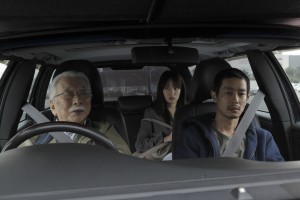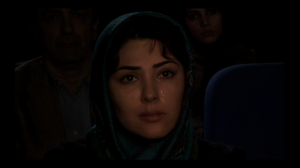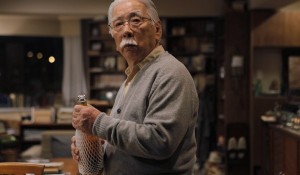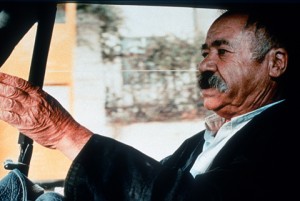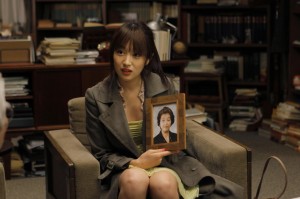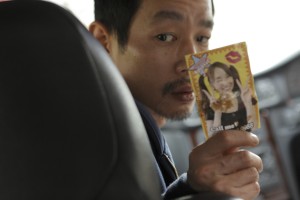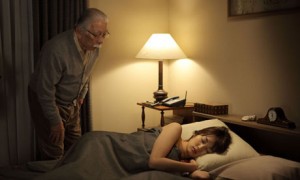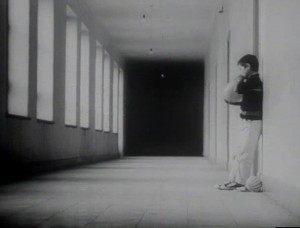An expanded edition of my book with Mehrnaz Saeed-Vafa, Abbas Kiarostami (University of Illinois Press, 2004), was published in Argentina by Los Rios, translated into Spanish by Luciana Borrini and Julián Aubrit. (A stil more expanded edition appeared in English much later, in 2018.) One of the two texts added to the Argentinian edition, my essay “Watching Kiarostami Films at Home,” is already available on this site, as are an essay about Shirin I wrote for the Cinema Guild DVD and an earlier dialogue I had with Mehrnaz about the film. Here is the other addition, written by Mehrnaz expressly for the expanded edition. — J.R.
Reflections on Like Someone in Love (2012)
By Mehrnaz Saeed-Vafa
I
A phone conversation between Chicago (Saeed-Vafa) and Rome (Kiarostami), March 17, 2013:
MS: When you talked about Shirin in one of your interviews, you said that it was a unique film that could have changed your career, if you had made it earlier. What did you mean by that?
AK: I wished I had made Shirin earlier to get a better emotional understanding of women. Shirin was like a silent, wordless interview with 117 women. You could tell that they were all thinking silently about their private relationships, and we could see their emotions in their faces. As Hafez says: “yek gesseh bish nist game eshgh o in ajab az har zaban ke mishenavam na mokarar ast.” (“Love’s sorrow is but one story, but this is the marvel, that from everyone that I hear it, it is never the same.”).
This was an amazing realization that I hadn’t had earlier. As you know, women didn’t have pivotal roles in most of my films.
MS: Regarding Like Someone in Love, did you have the ending it in mind or did you arrive at it while making the film?
AK: No. I had it when I wrote my script. It‘s interesting that my producer wasn’t surprised by it. And although I had a lot of time to think about an ending — my production was postponed due to the tsunami — this was the only one I liked, which is just like the ending of a classical movie. It seemed like a very reasonable ending to me. This is also true of the beginning; I thought of it starting suddenly. We can’t say that we can follow any story from the beginning to the end. Every story has starts before us and will continue after us. It was my choice to say the beginning was there and the end was here.
MS: I heard that you wrote the story 20 years ago.
AK: No, I never said that. I only said the image of this girl among the suited businessmen, carrying Samsonite, had remained in my mind from many years ago. I wrote the script when I thought we were going to make it. I only shot one sequence to see how it looked. We were looking for a square, but there wasn’t any in Tokyo. I had imagined shooting the sequence with the girl and the grandmother in a single take, but it wasn’t possible because there’s no square of that kind in Tokyo or Japan.
MS: It seems that the film is also a statement about the current condition of our global culture.
AK: We show part of ourselves in our stories but it’s up to the audience to discover the hidden parts. You’re not satisfied to see the characters and the story as they are, so you look for other things about them.
MS: How much did your actors know about your script and how did you work with them? Was it different from your other films?
AK: My script was written and translated but I didn’t give it to my actors. I would give them the information on a daily basis. Mr. Okuno (who plays the old man) was a movie extra and he had come to play an extra, but I chose him for the lead. I knew if I had told him that he was the leading actor, he would run off. He said he never had any dialogue. I told him that I had two or three pages for him, and asked him if he could learn those lines by heart. Reluctantly he accepted, but until the last moment we weren’t sure. The scene in his bedroom was the last one to be shot because, only then and there did he realize that his role was the key one, the leading role. Before that, he would come every day to the set, out of Japanese courtesy and discipline, and wouldn’t complain. He’d say why for such a small role do I have to be in your film all the time?
MS: Was it by chance that you made this film in Japan? It seems that Japan has some similarity with Iranian culture in terms of its traditional social values, like saving face at any cost, despite being very modern.
AK: If I hadn’t made this film in Japan, I couldn’t have made it anywhere else. My French producer was in fact very generous to accept that it be shot in Japan, because Japanese, even more than Farsi, is not a very familiar language to other people. The language of the film can influence the film’s commercial success or the lack of it. I told him that I couldn’t find people like the professor anywhere else. I’ve seen two or three men like him in Tabriz [a city northwest of Tehran]. But yes, the traditional and the modern are in contrast there. When I asked Mr. Okuno to hold the girl’s face when she had a toothache so he could check her teeth, he didn’t want to do it, even after four takes. You can hardly find such a man in other cultures. You can see the whores in Japan, but you can also see men like this at the same time.
MS: It seems that the film is talking not only about love relationships between men and women but also another kind of love — a love for young people and a desire to help them. I know that you’ve offered many film seminars in Iran where you haven’t asked for any payment, and I’ve seen how you have supported young filmmakers and even written scripts for some of them — a unique act of love and generosity, just like the figure of the old man in your film who wants to protect the young woman. And he also tries to give advice to her young boyfriend.
AK: Yes, he says, “I’m as much a grandfather to you as I am to her.” And in any case, when one gets old, one’s view of youth finds another form. But as for working with young filmmakers, I’ve just come from Spain, working with ki
ds from Latin America for twelve days, and two months ago I did a similar ten-day program in Strasbourg. It’s a different kind of pleasure, returning to the time when I made un- professional short films, when I didn’t have any commitment to anyone and worked for myself. It’s important for me to not get separated for those kinds of experiments. My goal is really not to help the kids — I have no responsibilities towards them — but it’s pleasant when, in this working relationship, I can learn while I teach.
MS: Where do these wise old men in your films come from? In Taste of Cherry, The Wind Will Carry Us — even in Bread and Alley, where the boy follows the old man wearing a hearing aid? Are they playing the teacher’s role, or acting as father figures?
AK: I think it’s both. Teachers do the fatherly job and fathers do the teaching work.
Personally, I have no great memories of my teachers. But our elders, who were not talkative, often gave us wise advice that was very instrumental. The best example was my dear father, whom I loved dearly. He was the most important person in my life and a symbol of wisdom. When my son was born, I named him after him. My father is probably the image of all these old men.
MS: Has your recent film shown in Iran?
AK: No. But I think it needs to be dubbed, because its language is very important. The tone of the language and the dialogue can convey many human emotions more effective than subtitles. I’m happy that you’ve seen the film more than once. I hope you’ve noticed the eyes of the players on screen. I chose those actors who had big eyes so you could see their emotions in their eyes. When there are subtitles in films, you don’t see the eyes.
II
Abbas Kiarostami’s second fiction feature to be shot outside Iran poses new challenges for his audience, who are faced with a familiar yet strange world that is beautiful, enigmatic, and disturbing. If Kiarostami’s Iranian films opened the door to reading his films in an Iranian social and political context, this new Japanese production invites its viewers to regard it within a much wider universal culture. And as Jonathan Rosenbaum has pointed out to me, now that Kiarostami’s most recent films are being made outside Iran, which automatically makes them appear less threatening and unusual in some ways than his previous films to many western viewers, several mainstream critics who previously dismissed his filmmaking have finally caught up with him.
Like Someone in Love revolves around three characters: a young prostitute who doesn’t want to go to her client, her jealous boyfriend who is angry at her, and an elderly client, who treats her with kindness. As the film progresses and we learn more about them, our understanding of their motives becomes more complicated and less predictable. The powerful formal emphasis on the appearances and the surfaces of interior and exterior spaces and their reflections — in particular the reflections on car windows — lead us to the philosophical and existential statements of the film about its illusory world while the meticulous observation of the non-action scenes brings us closer to the reality of the characters’ daily routines.
The film has plenty of long takes to convey a sense of real time, such as showing the old man climbing three flights of stairs to his apartment and then walking back down again — a Sisyphus-like act. Many of the car scenes were shot with two video cameras at the same time, to keep the perspectives of the locations real while intercutting.
Kiarostami has been increasingly drawing our attention to offscreen space and in doing so he has played with the audience’s narrative expectations. This is a cinematic approach that he most notably started with The Wind Will Carry Us, where we hear the film crew but never see them throughout the film. In his movement towards this kind of minimalism and ellipsis, Kiarostami has used sound both as a replacement for invisible characters and environment and as a kind of philosophical, existential or even humorous commentary on his characters’ predicaments, sometimes undermining or at least distracting us from their reality.
Like Someone in Love has plenty of such employments of sound. The most notable is its magnetic opening scene in a dark bar in downtown Tokyo, setting the mood of the film. We hear a young woman’s offscreen voice saying ”I’m not lying to you” over the interior of a crowded bar. It’s not clear who is talking and where she is. But there is an empty seat facing the camera in the center of the frame that suggests an absence, or a possible forthcoming entrance. We become even more curious when a young, heavily made-up woman from one corner of the screen starts making gestures to someone offscreen. The camera still resists going after the subject or showing the woman’s point of view, which contributes to the sense of confusion and ambiguity that is introduced here — suggesting, among other things, that anyone in this modern bar could be either a prostitute or a pimp.
This bar scene is reminiscent of the opening scene of Certified Copy, behind the credits, when we see a shot of a table with two microphones. There are no speakers in sight but we hear the whispering of the impatient audience offscreen. In Shirin, all we see is the audience who are apparently watching a film off-screen, as the sound track suggests. This geometry of looking and hearing (we as the audience look at the women, just as the audience in the film are watching something offscreen) creates a web of relationships between the subjects and off-screen space and us as the audience, participating in this voyeuristic experience that is both enigmatic and unsettling.
When the old man sets the “theatre of the night” by putting on the Ella Fitzgerald title song to create a romantic atmosphere, we hear the sound of his slippers on the floor as he walks and drags himself across the room under the music. This draws our attention to his physical reality and undermines the romantic mood that is supposed to dominate the scene.
Ever since Ten, Kiarostami has turned his camera on urban women characters and their relationships with men and the concept of love, a theme subsequently followed in Shirin and Certified Copy. If Certified Copy had moments of hope and possibilities between the couple, Like Someone in Love has a darker view of relationships between men and women, similar to the bleak image of the married couple’s life in Report, Kiarostami’s first feature. In Like Someone in Love, the young boyfriend is overly possessive, violent, and a complete novice, the young woman, Akiko, is confused (not knowing what she wants) and dishonest (lying to her boyfriend); and the old man, who is probably wise, is apparently too old for a romantic relationship with a young woman.
Interestingly, the film starts with Akiko and our sympathy is with her as she is forced by her pimp to go to a client. Then, on the cab ride there, she finds herself unable to confront or face her grandmother, who seems to be waiting for her on the street, after having left many voicemail messages for Akiko which she has failed to respond to, meanwhile telling the driver to circle the block again — one of the most beautiful scenes in the film.
But once she gets to her destination, the point of view of the film shifts towards the old man. We enter his apartment as he awaits his young guest, restless like an adolescent boy (looking through the window and watching her get out of her cab). He is the only character in the film whose house or private space is shared with the audience. Akiko and her boyfriend are always in public places (such as the bar, street, auto shop, and car). This old man is one of the few wise old men in Kiarostami’s films who occupies a central rather than peripheral role. And in fact, the question of the film mostly revolves around him, his desires and fantasies and his reality. One wonders, why has he sent for this young prostitute? Does he expect her to revive him in some way? Or is he after a fantasy, a dream of a lost time?
The premise of the film is some respect is similar to that of Gabriel Garcia Marquez’s novella “Memories of My Melancholy Whores” (2004), in which a 90-year-old man asks for a young virgin prostitute as a birthday gift. He never touches the “sleeping beauty,” but for the first time in his life, and probably because sex is no longer an issue for him, he falls in love with her.
Significantly, this novella was translated into Persian and published in Iran in 2007, but reports say that after selling 5000 copies it got banned by the Ministry of Culture on the charges of it promoting prostitution. The old writer in Garcia Marquez’s story, a womanizer, who has always paid for sex, never touches his teenage virginal sleeping beauty (who is tired and sleeps naked in his bed) and in this way he attains a certain sainthood in his old age.
Why do young virgins appear so often as desirable figures in Iranian, Middle Eastern, and Latin American (in this case, Colombian) culture? Are they desired because they have the power to revive their old mates, heal their old stained souls with their purity, innocence, heavenly powers, and charms, or is it their lack of sexual experience that is desired (which makes them ideal)? The old man in Garcia Marquez‘s novella prefers his teenage prostitute to be sleeping and not talking. He even calls her his “sleeping beauty”. He adores her beauty like a work of art — a fantasy figure who doesn’t speak or act, but poses for him as a sleeping model. In Kiarostami’s film, the young woman is also momentarily compared to a work on art, a Japanese painting hanging on the wall . She is sleepy and tired and always in a semi-conscious state, trancelike and passive. Yet she is much more real that the teenage prostitute in Garcia Marquez’s story.
In Like Someone in Love, we never see the old man sleeping with the woman or touching her or even staring at her naked body. The only image we see is the blurred reflection of the naked woman in the bedroom mirror next to a chair where the old man is sitting. What happens between them once they are in the bedroom is left to our imagination. The film cuts to the next day where we see both of them sleepy and tired in the car. The old man falls asleep behind the wheel (with almost fatal results — and with the suggestion that he might even be dying on the spot), an event shown in real time until other drivers behind him honk their horns.
The old man doesn’t look like someone looking for one last fling before he dies. But Kiarostami has taught us not to judge by appearances. The old man is lonely and apparently estranged from his own family. He is probably seeking company, but from a woman who belongs to a different generation. Here the young prostitute could be playing the role of a possible surrogate for a granddaughter that he has lost — echoing the concept of Certified Copy where two strangers play man and wife for each other (or a man and wife play strangers for each other).
The innocent liar figure, as a child or as an adult, has been at the center of many Kiarostami films, from The Traveler to Close-Up. But in this film, she takes on an erotic character. Akiko, the young childlike prostitute, is longed for and desired — if not by the old man, at least by the eye of the camera.
The scene where Akiko steps into the old man’s bedroom, lets down her hair, and takes her clothes off, is a quintessential erotic male fantasy-image — a sight that is viewed by the old man with intensity, perplexity, or perhaps even horror. It is not at all clear what he is thinking.
To the audience’s surprise, the film ends abruptly with a shocking, violent act. Here the window of the old man’s apartment becomes the screen/frame, and unlike all the other windows in the film, including the neighbor’s window and the car windows, this one gets smashed — a reality that tears apart the movie screen — and a barrier between the audience and the image is suddenly broken.
When I first saw the film’s ending I couldn’t help but think about the beginning of one of Kiarostami’s earliest shorts films, Recess (Zang-e Tafrih, 1972) where a boy’s soccer ball hits the window in a school hallway and breaks it. Through the broken glass, we see the boy getting beaten by the principal, and feel his anguish as we watch the broken glass in the foreground coming into focus. A playful act on the part of two boys ends in violence. That’s the earliest scene in a Kiarostami film where a window becomes central, and part of the frame separating us from the boy. In this case, we discover that the old man’s apartment is no longer a safe haven, and he is no longer able to protect the young woman; both are threatened by the violence and rage of her boyfriend. Like Someone In Love has become, in effect, the antithesis of Michael Haneke’s Amour, where we see an old couple in harmony and in love, still caring for each other.
When I brought up Kiarostami’s emphasis on windows to him in our recent phone conversation, he agreed that it was there, but added that it was unconscious. Then he added, “The relationship between our inner worlds to the outer world is through these windows. One side of it belongs to us, it takes care of our safety, and the other side belongs to outer world that we have no connection with, and it is strange that it is transparent…Now that you mention this, I can think of other examples — The Wedding Suit, Experience, Taste of Cherry.”
The characters’ alienation — lack of connection and isolation, both from each other and from the rest of the world — and their fear of violence also recur throughout Kiarostami’s oeuvre, presented with varying degrees of realism (in his Iranian films) and abstraction (in his later films, especially Like Someone in Love). As early as Bread and Alley (1970), his first short, we see a boy’s fear of violence when he is threatened by a hungry street dog and his loneliness in trying to cope with that threat, as well as with the indifference of several adults who pass by, including an old man whom he follows to protect himself but who proves to be useless.
In Like Someone in Love, the violent conclusion can also be regarded as another unresolved Kiarostami ending, addressed to the audience — an image and metaphor that take us beyond the film’s story, and into a bleak view of modern life and our violent times, where Tokyo is not a place but a state of mind. It’s worth noting that film’s original title was The End — as in the end of old movies, or maybe even the end of life itself.


